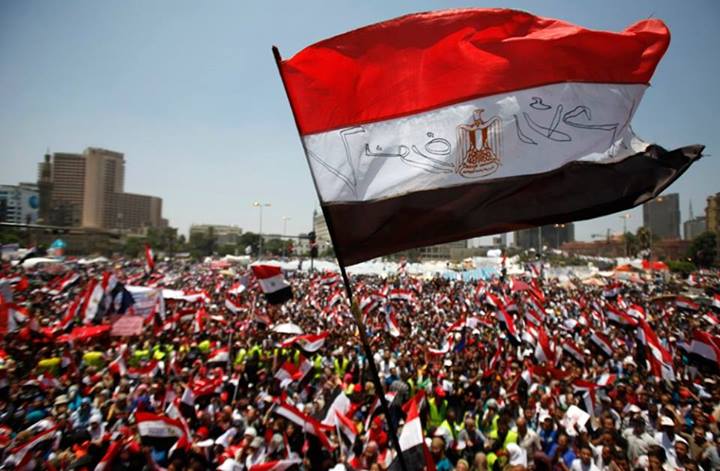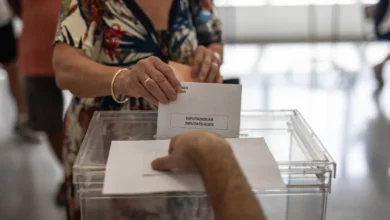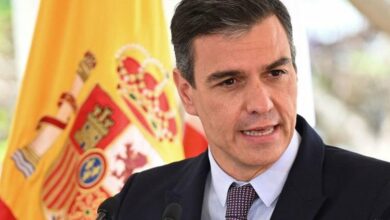The One and the Multiple, an exhibition currently at Artellewa–co-curated by Pedro Soler, director of the Barcelona center Hangar, and Hamdy Reda, artist and director of Artellewa–celebrates workshops and residencies that have enabled artistic exchange between Spain and Egypt.
The exhibition takes up Artellewa’s small space and a large nearby basement that will house the Noshokaty Foundation for Contemporary Art Education. During the opening, on 14 December, the alley between the spaces was also part of the show, filled with people and sounds.
Amid strings of colorful lights, a stage and a sound system, the viewers mingled with the locals. Music by DJ Saasci and the Sudanese Alwazza band, as well as live sound pieces by Sharif al Azma, Nork Zakarian and Magdi Mostafa provided a soundtrack for the work and gave the opening a party atmosphere.
Mostafa’s “Transparent Existence” is a version of the piece he showed in Invisible Presences, an exhibition Mashrabia gallery put on earlier this year at the Mawlawiya complex in Islamic Cairo. At Artellewa tiny lights outline a geometric shape on the ceiling of a dark room, accompanied by recordings taken underneath the Mawlawiya dervishes’ stage: echoing drips, creaks, rattles and rumbles, silences and singing heavy with reverb.
The show makes good use of the Noshokaty foundation basement’s oddly-shaped spaces. In an installation from Nork Zakarian–made at the 2009 Open Lab Egypt (OLE) interactive video workshop (co-produced by Medrar for Contemporary Art and Hangar)–a video is projected onto a freestanding door in the middle of a dark room and another projected on the wall beyond. The video on the wall stops when people pass the door, and the one on the door stops when they return to look at it. Because it’s only possible to see both videos simultaneously by standing back, one may not discover the interactive nature of the work until informed of it.
Alvaro Sau’s “The Valley of the Whales” is made of two stacked TV monitors showing videos made with footage shot in Egypt. To see the screens the viewer has to bend into a cave-like recess and stay bent while watching. In fact, it is only the presence of hunched viewers that indicate there is something to be seen. The work acts as a sculpture as well as a moving image piece. Sometimes the videos are green and blue color-fields, and sometimes patches of light and people’s faces appear.
Nearby hang sleekly framed black and white prints from Sameh Ismail and Hamdy Reda. “Isolation Rites” is the third installment in a collaborative project that began in 2005. They combine Reda’s blurry pin-hole photographs of old buildings with Ismail’s graffiti-like, often abstract, calligraphy. The mystical effect relates to the dreamy atmosphere of Mostafa’s work.
Shady el Noshokaty, who visited the LABoral center in Spain, contributed a piece viewers may have seen at his solo show at Darb 1718 earlier this year. From the ongoing “Stammer” project, humorous yet tortured, the video has the series’ consistent set-up and aesthetic: Noshokaty stands in front of a blackboard, brokenly reading a text (in this instance on rats), sometimes drawing pseudo-scientific diagrams.
Vahida Ramujkic’s collaborative “Weave & Construct” project involves textile explorations of cities (including Cairo) through embroideries made in the street. In The One and the Multiple, clothes and quilts hang, roughly embroidered with words and images. These creative maps link to the projects of Pablo de Soto, an erstwhile resident at Townhouse who’s interested in the political function of map-making. His work incorporates changing maps of Gaza over time with a video called “From Cairo to Gaza” which takes place on the Egyptian side of the Rafah border during winter 2009.
Lafundacio’s video “Canal Canatum” incorporates footage from workshops with children in Catalonia and Ard al-Lewa, and is accompanied by books made by the participants.
Tarek Hefny (who spent time at Hangar) shows tightly-framed photographs of the facades of buildings. Mahmoud Khaled (who also went to Hangar and currently has a solo show at CIC), wallpapered a wall with a grid of almost identical images. Wensh (who took part in the OLE workshop) created an interactive sound corridor (that can be experienced at the Hotel Viennoise in downtown, in a show organized by Medrar) and posted posters around Ard el Lewa.
While some works deal with cultural exchange or site-specificity, there doesn’t seem to be an imposed theme. There is a mix of community craft projects, educational research-based works, and more self-contained pieces, and they fit together with surprising ease.
The exhibition is open through 27 December.




